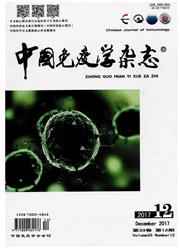

 中文摘要:
中文摘要:
目的:分别构建两个高效表达人突变CD59的CHO细胞真核表达系统,探讨突变CD59基因表达蛋白糖基化前后抗补体活性的变化,为在基因水平阐明糖尿病血管增殖症的发病机理奠定基础。方法:将两种含不同突变基因的人CD59全长cDNA序列(HM7、HM8)的重组pALTER质粒运用阳离子脂质体导入法共转染CHO细胞,用含有400μg/ml新霉素类似物(G418)的F12培养基筛选出阳性表达克隆,应用荧光免疫组化(FIH)检测CD59在CHO细胞表面的表达。经染料释放试验检测突变CD59糖基化前后抗补体活性。结果:运用阳离子脂质体导入法将重组pALTER质粒与pcDNA3质粒共转染CHO,成功筛选出的阳性克隆经FIH证明突变CD59可在CHO细胞表达。染料释放法证实两种突变CD59均具有抗补体活性,且在高糖环境下易糖基化,糖基化后抗补体活性明显降低。结论:建立了两个高效表达突变CD59的真核表达系统,获得阳性克隆细胞株。初步研究证实突变CD59具有抗补体活性,糖基化后抗补体活性明显降低,为单克隆抗体的制备奠定了基础。
 英文摘要:
英文摘要:
Objective: To amplify two human mutant CD59 eukaryotic expressing systems and investigate mutant CD59 functional activity. Methods: Mammalian expression vector PLATER of mutant CD59 cDNAs was transfected into CHO together with the pcDNA by lipofectamine,which confered resistance to G418 (400 μg/ml). The positive clones were tested by FIH. Activity of both mutants CD59 was determined by BCECF release assay. Results:Mutant CD59 cDNAs subcloned into the mammalian expression vector PLATER and transfected CHO together with the pcDNA,which confered resistance to G418. The positive clones were tested by FIH. Activity of both mutants CD59 before and after glycation was determined by BCECF release assay, both of them could restrict MAC formarion ,and glycation could inhibit CD59. Conclusion:A eukaryotic system that expressing mutant CD59 cDNA was successfully set up. It was found that mutant CD59 could restrict MAC formation, and glycation could inhibit mutant CD59. These would be helpful for the furthur study of link mutant CD59 and the vascular proliferative of diabetes.
 同期刊论文项目
同期刊论文项目
 同项目期刊论文
同项目期刊论文
 期刊信息
期刊信息
